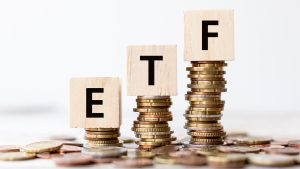Find the German version of the interview here.
This story is really crazy: A young Englishman goes to China and finds his financial and private happiness there. We talked to the guy behind the blog P2P Millionaire to unlock the secret of his achievements. In the interview Sterling not only talks about his € 1 million investment on the P2P platform Mintos, but also about the ETFs he invested in.
ETF Nachrichten: Tell us a little bit about yourself. Who is Sterling?
Sterling: I am originally from the UK and am in my early thirties, married with two young children. We live in China, where I manage several factories for a large multinational industrial group. Our factories produce a wide range of industrial products which are sold in almost every market around the world.
I first moved to China in 2009 after graduating from a UK university with a degree in Economics and Finance. Through a personal connection, I was put in contact with the owner of a company who was looking for someone to take on a very specific task. I pledged a 5-year commitment to help him with a key project in China and my reward was to be a small issuance of shares in the company plus a cash bonus upon successful completion. This was also an opportunity to impress the owner, in the hopes of securing a top position in the company when he eventually decided to retire from day-to-day management.

I therefore entered the company on a unique, fast-track managerial pathway and was thrown into China to wrestle back control of the company’s supply chain from two Chinese partners, who were not acting in the best interests of the company.
During the initial period I learned Mandarin, set up several new company structures, hired and trained more than 200 staff, set up the company systems and processes and ultimately switched over the supply of the key products to our fall-back suppliers. After securing the supply of products, we went on the offensive and started legal proceedings against the bad actors, eventually winning our case in Chinese court. The initial project took 3 years and was a total success.
Of course, I was not alone in this endeavour and received great support from my mentor, the company owner.
After removing the bad actors, we re-started a growth phase in the business under the new structure. My mentor made good on his promise and I became a minority shareholder in the business.
Fast forward a couple of years and the owner decided to sell the business to a billion Euro industrial group, who are now my current employer. My shares were converted into cash, and this is the primary source of my current net worth, which stands today at between €3m and €4m.
During the course of this journey I met my wife, a fellow European living in China and we were married. We now have two young children and a comfortable lifestyle.
The new owners of the business have recognised my past achievements and have given me responsibility for the management of several of their existing Chinese operations, as well as the factories I set up myself.
People who know me say that I am at my best when I am busy, and I certainly keep a full schedule!
ETF Nachrichten: When did you start investing on P2P lending platforms?
Sterling: My first foray into P2P lending was in Q4 2017, with a platform called Twino. I can’t remember how I first came across it, it was probably an online advert I clicked on and started to do some research.
Before that I had considered entering the Buy-to-Let housing market in the UK both as an investment and a way of keeping skin-in-the-game with the UK property market in case I ever decided to return.
Eventually, I decided to use several property crowdfunding platforms instead of entering the market directly. This was because I valued the diversification achieved through these platforms, as opposed to investing in a single property alone. There was also an added value in the liquidity those platforms provided, as shares in property projects could be resold to other investors without the need to liquidate the investment itself, also avoiding all the associated hassle and transaction costs.
This set the scene for my future move into P2P lending, a close relative of property crowdfunding.

I seriously entered P2P lending in Q1 2018 with an investment in Mintos, the leading platform in Europe.
ETF Nachrichten: What was your starting capital?
Sterling: At the beginning I started Mintos with €100,000 exactly. Like most people I have an irrational preference for round numbers, but it also allowed me to easily track my percentage investment returns at a glance.
Once I became comfortable with the concept of P2P lending, and better understood the risk/return proposition on offer, I started to increase my investment.
ETF Nachrichten: On which P2P lending platforms do you invest? How big is your P2P portfolio? How do you set up your auto invest?
Sterling: I publish the full details for my P2P portfolio on a monthly basis on our blog – if you are interested to see how the portfolio develops over time, feel free to check it out here.
Currently my portfolio is split between my ‘main’ portfolio which is €1.3m, of which more than €1m is in the market leading European P2P platform Mintos.
There is a further €270k in what we call „The €10k Club“. This is our flagship platform tracking portfolio which was launched in April 2019.

This has been a popular initiative, as sometimes actual returns diverge from the platform stated returns. This portfolio cuts through the marketing numbers and lays bare the true returns that can be achieved and shows exactly how to achieve them.
As well as the auto invest settings for the 26 platforms in The €10K Club, I am also well known for publishing a detailed explanation of the auto invest settings and strategy I use for my €1m Mintos portfolio.
Here, I go into the strategic theory behind my Mintos portfolio allocation strategy and give a step-by-step setup guide for others to create their own strategies.
ETF Nachrichten: What`s the percentage of P2P in the total mix of your investments/capital? What are your other investments? As we are an ETF news platform: Do you also invest in ETF?
Sterling: If I do not include non-liquid assets such as land, property and business interests then P2P investments currently make up around 50% of my liquid assets. The other 50% is invested in ETFs, with a current value of approx. €1.7m.
I am sure your readers will be familiar with a diversified, passive investment strategy, which is exactly the one I have taken. I hold two ETFs only, VWRL which tracks the FTSE All World Index, and VETY which tracks the Barclays Eurozone Gov Bonds index.
I started off 2019 with 75% Equities and 25% Bonds, but I have been selling VWRL and buying VETY over the course of the year with a plan to enter 2020 with a more defensive 50/50 allocation.
I know true buy-and-hold passive investors would be unimpressed with my market timing approach, but I believe there will be another serious bear market within the next two years, so I am preparing my portfolio for the storm.
When the storm hits, I plan to immediately start rebalancing the other way; selling VETY and buying VWRL until I get back to 75% equities, 25% bonds.
In this way, I hope to be able to buy cheap VWRL and get prepared for the next part of the economic cycle, the market recovery.
That’s the plan anyway – I’m sure Mr. Market will have some surprises for us!
ETF Nachrichten: What is your monthly profit from P2P?
Sterling: My current self-calculated XIRR return is 11.70% per annum. On a portfolio of €1.6m that should equate to around €15,600 per month profit. However, my portfolio hasn’t been at €1.6m for the full year, as I took out more than €1m for March and April while I investigated another investment opportunity.
If you have a look at my portfolio snapshot above, you’ll notice some cash drag in my portfolio in the last three months while I restructured some of my investments to hold them through corporate structures. This has hampered returns as you can see from the monthly profit chart.

My actual profit for the first year of the portfolio was €146k, which is a little over €12k per month on average.
ETF Nachrichten: How do you assess the risks of P2P lending platforms?
Sterling: Your question asks about the lending platforms specifically, but I would like to talk first about the industry as a whole.

Those who are new to P2P lending are right to often ask how the industry might fare during the next economic downturn – I would say it is the biggest concern for new and existing investors alike.
Other than a few pioneer platforms that were around in 2007/2008 for the global financial crisis (Zopa in the UK for example) we have no historical data to look at.
What we can do however, is to look at other sectors which might react similarly under the same conditions.
The primary risk in P2P lending is default risk – that the end user cannot pay back the original loan. The risk during an economic crisis is that the demographic who take out these loans will be less able (as an aggregate population) to pay them back, and the rate of defaults will rise. During an economic crisis, this risk increases, because them demographic who typically take out these loans are less able (as an aggregate population) to repay, and the default rate increases.
One sector we can look at is the credit card industry, which shares a lot of similarities with P2P lending. Credit cards are unsecured loans with high interest rates, issued to large numbers of consumers. This is of course a generalisation; there are many differences between P2P and cards, and there are also many different types of P2P loan. However in the absence of a historical P2P data set to refer to, this seems like the closest alternative.
The following charts are produced by the US Federal Reserve regarding the USA credit card industry.
We can see from these data that the peak in default rates lags the start of the recession by at least a year.
We can also see, that despite the rise in defaults, the net return for the aggregated industry remained positive for the entire period shown. Therefore, a diversified investment that aims to track the whole industry would continue to have positive returns despite the rise in defaults – that is to say the spread in rates offers sufficient room to absorb the rise in defaults.
So we can infer two key findings from this example:
1) Net returns for unsecured personal loans are correlated with the economic cycle.
2) This correlation lags by at least a year.
This makes sense to me from both a macro and micro perspective. Once a period of economic contraction occurs, it takes time for the effects to filter down to consumers and for there to be a corresponding increase in defaults.
The strategy I currently have in mind for my investment portfolio (both ETF and P2P) is to exploit this lag in correlation.
Once we are firmly into the next recession, I will make the decision to pause the auto invest profiles on my main P2P portfolio and allow the interest and principal payments to collect as cash. During this time global equity markets will be soft and I intend to shift the P2P investments over to VWRL to take advantage of cheaper global stocks.
As your readers will no doubt understand, the Gov bond portion of my existing ETF allocation VETY is not strongly correlated to VWRL, and will not fall as quickly or as low as global stocks. This is often called the ‘flight to quality’.
As explained earlier, in my ETF portfolio I will be actively selling VETY and buying VWRL in a structured way, to take advantage of the falling VWRL price.
In this way P2P and VETY are two stores of capital which I will use to buy cheaper VWRL once the next serious economic downturn arrives.
To bring the answer back round to the question about platform risk. I look at individual platform risk in the same way as I look at investments in individual companies.
The first thing I recognise is that even though older larger companies can fail (e.g. Lendy in the UK) they are less likely to fail than new, small companies. The same holds true for P2P platforms where generally the older, established platforms present a lower risk of platform failure than the newer, unproven platforms.
The second thing to look at is the health of the platform itself – is it profitable? If it isn’t profitable now, is the business model viable to reach profitability in the future? Is the business growing? Is the platform improving their features over time? Are they transparent with their data?

The third aspect to think about are the underlying assets that are being offered. The P2P industry covers a great deal of different types of borrower and one should really understand the risks for each particular type of loan invested in. Not all P2P loans are created equal and this is of critical importance to understand, especially when comparing platforms and returns.
The last thing, and possibly the most important thing to consider is one’s own risk tolerance – this should be a familiar concept for ETF Nachrichten readers so I won’t labour on this point.
ETF Nachrichten: What is your aim as an investor?
Sterling: My overall aim is to have €10m invested in my ETF portfolio before I turn 50 with the portfolio allocation at 50% VWRL and 50% VETY.
ETF Nachrichten: Why did you start your blog P2P Millionaire?
Sterling: This is a typical British story, in that it starts with two best friends, drinking ale in a pub garden, catching up with each other after a long period apart.
Scrappy, my co-blogger on P2P Millionaire is also my childhood friend – we have known each other since we were wearing short-shorts and long socks. Whenever I am back in London, we make sure to clear a whole afternoon and evening to sit, drink and talk. It is our long-held tradition.
Over the course of one particular catch up, while discussing money my investments in P2P lending came up. I had a few beers inside me and a lot of information to share with my dearest friend, who had never really considered P2P as an asset class, so the conversation flowed as freely as the ale.
During a pause, Scrappy asked if I had ever considered producing an online course about P2P lending, as clearly I had a great interest and high level of knowledge in the subject. I liked the idea of being able to share my knowledge with others in a structured way, and this idea later developed into our blog P2P Millionaire.
Scrappy has since started investing in P2P as well, and our blog tells two different stories: from the point of view of both the high-net-worth, and the aspiring, investor. We want to share our respective journeys and be a source of information, insight and inspiration for other investors.
Our vision is to ‘be the most trusted and respected source of P2P industry knowledge’ and we welcome ETF Nachrichten readers to check out our site and get in touch through the comments section if they have any questions or feedback.
Jeder Handel ist riskant. Keine Gewinngarantie. Jeglicher Inhalt unserer Webseite dient ausschließlich dem Zwecke der Information und stellt keine Kauf- oder Verkaufsempfehlung dar. Dies gilt sowohl für Assets, als auch für Produkte, Dienstleistungen und anderweitige Investments. Die Meinungen, welche auf dieser Seite kommuniziert werden, stellen keine Investment Beratung dar und unabhängiger finanzieller Rat sollte immer wenn möglich eingeholt werden.
Klicke Hier, um die besten Krypto Presales zu sehen, die sich in diesem Jahr verzehnfachen könnten!










